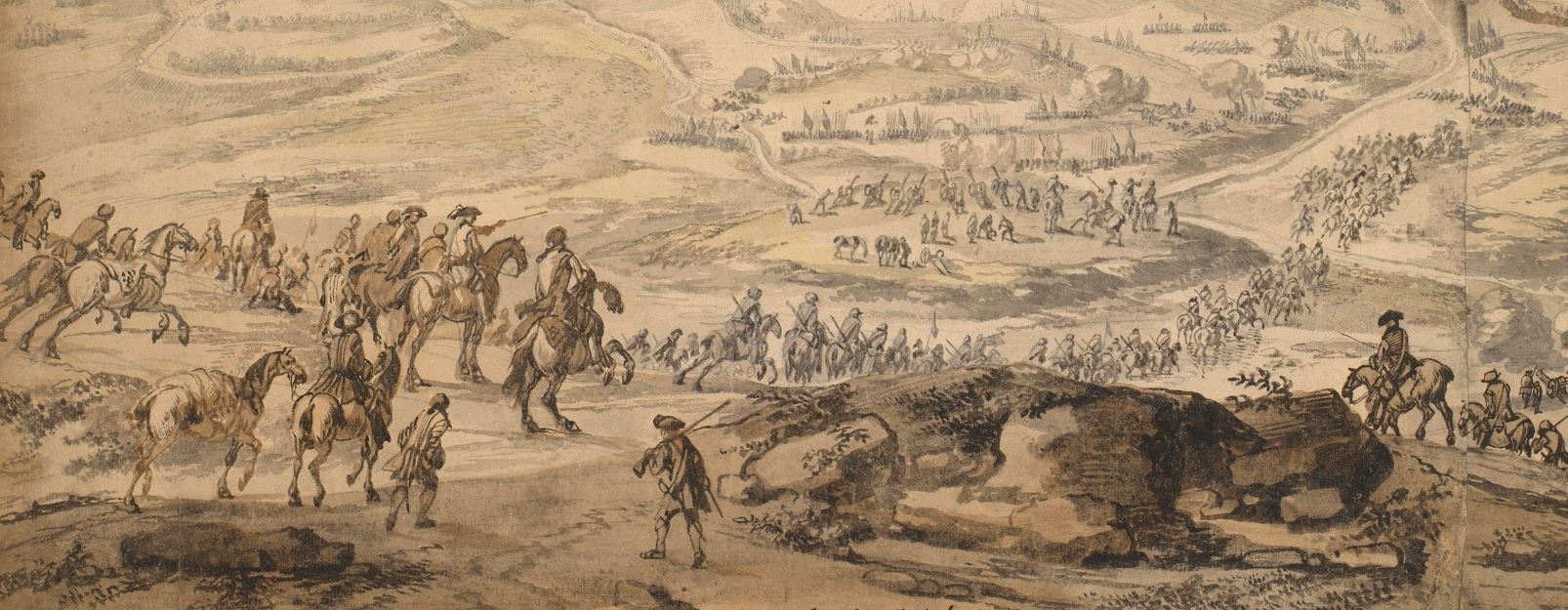
Printed and manuscript maps, prints and views of 22 seventeenth-century wars
View of Dogger Bank, 1652 (Dogger Bank, North Sea, UK) 55°00'00"N 03°00'00"E
1652 or laterEtching and engraving; printed on the same sheet of paper as the accompanying letterpress text in three columns; laid down on on stout rough paper which also forms a mount | 13.7 x 19.1 cm (image and neatline) | RCIN 723097
A view of a dispute between English and Dutch fishing vessels in the North Sea between Dogger Bank and the Schlagen Reef, 9 August 1652. First Anglo-Dutch War (1652-1654).
The BM entry records this as a broadside of a skirmish between Dutch and English fishermen just after the outbreak of the First Anglo-Dutch War in July 1652. 'According to Hollstein, the print was made after a drawing by Hendrick Averkamp, which seems unlikely since Averkamp died in 1634. The print may have been published in Amsterdam, the place of activity of Allard.' For another impression of the same print, see BM 1870-10-82884.
The catalysts for the First Anglo-Dutch War were first, the passing of the Navigation Act which was aimed against Dutch shipping and, second, the disputes over control of the profitable herring fishing in the North Sea. War had been declared between the two countries on 10 July 1652, just a month before this skirmish between two herring fishing boats took place.
This incident, according to the manuscript note below the print, was reported in the Hollantsche Mercurius for 1652, under the accounts for August of that year. It seems that the confrontation occurred somewhere between the Dogger Bank and a shoal known then as the Schager Reef between English and Dutch fishing vessels. The Dutch appear to have been Vlielanders, coming from one of the Frisian islands. The two sides appear to have taunted each other and the Dutch threw stones and flaming sticks into the English ship, getting the better of their foes. In the aftermath, the Dutch captain, Jonge Kees was given a medal, which hung on a blue cord, on one side of which were the arms of the Admiralty and on the other a depiction of the two ships. His portrait is top left of the view and the presentation of his medal is shown top right.
Hugo Allard the Elder (1627-84) (printer) [bottom right of view, a monogram:] HA [or] AH FE[cit].
Subject(s)
Navy-DutchNavy-EnglandWatermark: Map and text: indistinct. Backing paper/mount: none visible.
Condition: mounted on stout rough paper
13.7 x 19.1 cm (image and neatline)
14.0 x 19.5 cm (platemark)
33.1 x 25.8 cm (sheet)
42.6 x 27.8 cm (mount)
Printed title:
SCHEEPS-GEVECHT, / Tusschen een Engelschen en Hollandtschen Visscher; / Gheschiedt op den 9. Augustus, 1652. [on letterpress text, below view]
Additional text:
[in three columns, letterpress gothic and Roman fonts, gothic text begins:] Goetgunstige Leser [printed character, forward slash:] / alsoo my is ter handt / ghekomen een seecker Memoriael [printed character, forward slash:] / van / een Scheeps-gevecht … [Roman text, in second column, begins:] LOF-DICHT, / Over de Victorie van den Vlie- / lander Visscher … [In Gothic type, end of third column, a key, A-D].
Annotations:
George III heading: Naval Engagement 9 August 1652.
Other annotations: (Recto) [on mount, below text, ink, in seventeenth-century hand?, begin:] In de Hollantsche Mercurius van den jare 1652. onder de maent Augustus (gedrukt by Pieter Casteleyn,) vind men / pag. 105. dit Vissers-gevecht beschreven aldus: “Den 9 deser ontmoette, tusschen ’t Schager Rif en Doggers Zandt, malkander / twee Vis-scheepjes, ’t een een Engelschman, ’t ander een Vlielander, ieder met agt Eeters voorzien: den vlielander, Jonge Kees ge / noemt , Man te roer zynde, verzogt van d’Engelschen een zoode Vis, alsoo hy maer even in Zee quam, en nog geen Wandt uitgesmeten / hadde; maer d’Engelschen meenende dat de Vlielanders, met hun spotteden, begosten die te schelden, roepende: You Rogs, you Rascalls / and Fellows, you Rogs must be hanged. d’Engelschen wilden aen Boord komen, gooiende al van verre met steenen, waerop de / Vlielanders, ziende dat het Ernst was, gooiden wederom met Brandhouten, en al wat zy los krygen konden; als nu aen beide / kanten niet meer te gooien was, quamen zy aen Boords, de Vlielanders met het Mesje in de mont sprongen over, en joegen d’Engel / schen in ‘t Ruim; waerop Jonge Kees de Luiken doende toespykeren, heeft hem in ’t gezicht van een Engelsch Convoyer naer Amsterdam / gebracht, daer men d’Engelsche Vissers heeft laten loopen; maer hun Scheepje is tot Buit van de Vlielanders gebleven, die om haere / vroomheit, door de gecommitteerde Raden ter Admiraliteit, ieder met een gouden Rozenobel wierde vereert, en Jonge Kees (Beleider / van ’t Werk,) een goude Medaille, die hem aen een blaeuw Snoer om den hals wiert gehangen: op d’een zyde stond het Wapen / van d’Admiraliteit, en op d’ander zyde twee Vis-Scheepjes, daer men uit het een met Brandhout, en uit het ander met Steenen gooide.” (Verso) none.
George III catalogue entry:
Naval Engagement Scheeps-Gevecht tusschen een Engelschen in Hollandtschen Visscher, gheschiedt op den 9 Augustus 1652. W fecit. (with a Description)
Subject(s)
Dogger Bank, North Sea, UK (55°00'00"N 03°00'00"E)
Page revisions
25 May 2024
Current version






